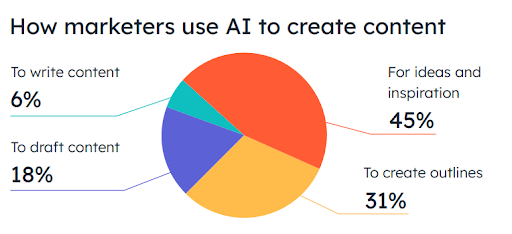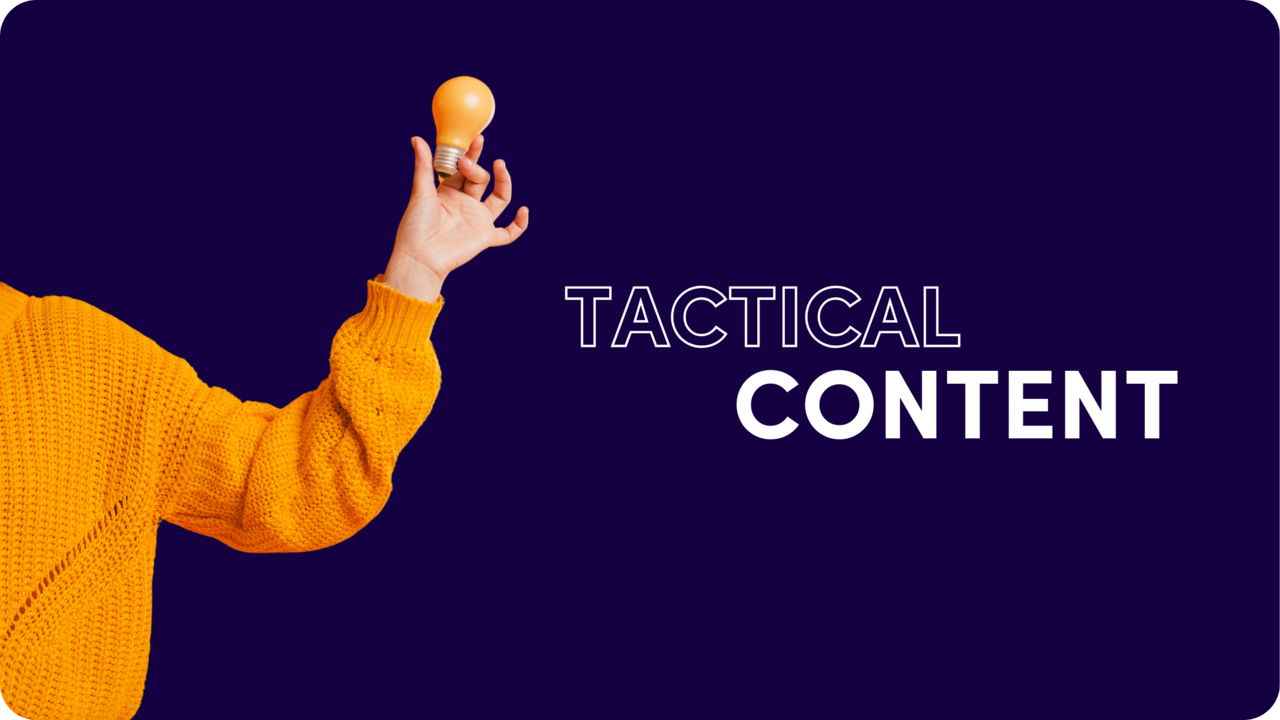5 Content Marketing Trends for 2024

Content marketing is not going anywhere. In fact, demand for content is the highest it’s ever been. And marketers are more than happy to match it.
According to HubSpot’s 2024 State of Marketing Report, 50% of marketers plan to grow their content marketing investments in 2024.
And with the growth of online content, there is also increasing competition.
It is getting harder all the time to make your content stand out and get noticed. This is driving all sorts of gimmicks and trends – some will fall away but others will stick and become a staple of a good content marketing strategy.
What’s happening in 2024 in the world of content marketing? Let’s take a look at the 5 top trends to bolster your content strategy and get more from your content-based campaigns.
AI Tools & Automation
AI and automation have been hanging around for some time, but it was ChatGPT’s unveiling in 2022 that helped it break into the content marketing mainstream. OpenAI’s creation spawned a surge of AI-driven tools that are reshaping how marketers approach content marketing and strategy.
The first, and perhaps the most obvious, content marketing trend for AI is that of scaling content creation. No matter how skilled a writer is, they have a finite capacity to produce high-quality content. AI can generate content at a much faster rate, but it has its drawbacks too, namely it can be repetitive, unoriginal, and simply chews out ‘new’ content based on existing content. It is not recommended to simply use the raw content produced by AI. Great content must have a human touch. Use AI for things like creative brainstorming and developing outlines for articles. Provided it is used correctly, a skilled writer with AI can work faster and smarter than without, and produce more content in less time.

AI can also enhance content marketing ROI by helping you analyze large amounts of data from various sources. Before AI, you needed to manually comb through data from search engines, social media, and competitors to find relevant keywords and topics. Now, it takes a couple of clicks. You can even ask AI to populate a content calendar with the best content ideas and optimal posting times for each channel. Having AI deal with these tasks frees up resources you can invest elsewhere.
Another area where content marketers can enlist AI’s help is SEO. What’s cool is that it works for all aspects of SEO – on-page, off-page, and technical. For example, you can ask AI to analyze your articles’ keyword density. Or you can ask it to find relevant link prospects who would benefit from giving you a backlink. On the technical SEO side, AI can help you find and fix technical errors like broken links and 404 errors, and suggest ways to improve performance metrics such as page speed.
Focus on Attention
Digital marketers have typically relied on metrics such as page visits or impressions to gauge the performance of a blog or webpage. However, those metrics lack nuance. If visitors land on your blog but leave quickly, your page visits will grow, but this won’t contribute to meaningful traffic or engagement. A much better way to measure content marketing performance is to look at whether and how users are interacting with the content.
There are several types of tools to help marketers do this:
- Heat maps offer a visual representation of where your users spend most of their time on a page, what they click on, and how far they scroll.
- Dwell time is the time a visitor spends on a page before returning to the search results.
- Session recordings allow you to watch how users navigate, scroll, click, and complete forms on your website.
- Funnel analysis helps you track how users move through different stages of your conversion funnel, such as landing page visits, sign-ups, and checkouts.
A new and upcoming metric in content marketing is attention metrics, which measure how engaged or focused an individual user is on a digital advertisement. These metrics consider factors like how long a user looks at an ad, whether they interact with it, and whether their engagement leads to meaningful actions, such as conversions.
Traditional metrics may show reach, but they don’t always translate to effective engagement or brand recall. Attention metrics fill this gap by providing insights into how captivating and memorable an ad is to its audience. The move to attention metrics will be crucial in digital marketing campaigns, directly impacting the ROI of your content marketing efforts.
Personal, Conversational Content
In 2024, the shift towards personalized, conversational content continues. People enjoy interacting with other people, not ‘soulless’ corporations. At the same time, people also realize that they will be dealing with chatbots and automated systems more and more. They don’t necessarily have a problem with that, as long as the interaction is useful, effective, relevant, and friendly.
That’s why brands are now adopting a more personal and conversational approach in their content, mirroring human interactions. What does personal, conversational content look like? Here are some examples:
- Creating content that speaks directly to the audience’s experiences, needs, and emotions, as if it’s coming from a trusted friend or advisor.
- Encouraging two-way dialog, such as running surveys and discussions on social media, or creating community-driven online events.
- Sharing employee experiences or success stories to show how real people are working to solve the customers’ issues.
- Using marketing automation to deliver tailored content and experiences to different customer segments.
The goal is to make your brand feel more human and relatable. A brand that your customers can rely on to solve their problems. This should be an underlying driver of your content creation and strategy in 2024.
Repurposing Content
Great content is evergreen content. Content that has no expiry date and can be used again and again will generate better ROI than time-limited content that is only relevant for a few weeks or months.
The longer you can promote a piece of content, the more people will see it, and the more value it will provide.
Repurposing content means taking existing content and giving it new life by adapting and updating it for different platforms and formats.
Let’s say you created an in-depth blog post about a topic that is popular among your readers. It performed pretty well, getting good page views and engagement. Why not take some of the best parts and publish them again? For example, turn the most important quote into an X post, summarize the article in a catchy TikTok video, or even refresh the design as a downloadable PDF and promote it via your email list.
Or perhaps you recorded a fantastic podcast with a special guest. Why not take the transcript, edit it, and publish it as an article on your blog?
You already spent time and effort in creating the original piece of content. Repurposing it maximizes its shelf life and distribution. Different people have different content consumption habits – repurposing is a great way of reaching readers in all the different places you might find them online. Some people who could enjoy your content might never find it via Google search, but could run into it on YouTube or via a native ad on their favorite news site.
Plus, it’s easier than ever to repurpose content thanks to AI generative tools. There’s no excuse to not repurpose your old content that’s performed well. It’s a win-win tactic, so go for it.
Video, Of Course
Yes, video is a key content marketing trend, year after year. That’s because consumers everywhere just can’t get enough video – they continue to watch and engage with video content, so it keeps seeing wild growth.
As reported in the CMI Video & Visual Storytelling Survey of 2023, 67% of content marketers say that video has become more important for their strategy than in the previous year.

Wyzowl also concluded that 88% of marketers see video content marketing as an important part of their overall strategy.
Video’s continued dominance in digital marketing can be strongly attributed to mobile technology. Today, most people have a powerful mini “TV” in their pockets, with sophisticated 5G or WiFi access to data and content everywhere they go. Consuming video on-the-go used to be a luxury, but now it’s a commodity. With the rise of “shorts”, or biteable video clips in a continuous feed, together with shorter-than-ever attention spans, video content marketing is not just a trend, but an absolute must.
Plus, video has a wide variety of formats businesses can play with. As video continues to reign as a key tool in content marketing, marketers experiment with its potential across more platforms and diverse video ad types.
For example, Outbrain’s digital platform offers several video ad formats, such as Clip ads for short animated ads, and Click-to-Watch formats that encourage deeper interaction. Pre-roll video placed contextually within premium content is the ideal choice for brands to increase visibility and audience engagement in versatile and innovative ways.
Content Marketing in 2024: Wrapping Up
In 2024, we’re seeing continued trending of classics such as video content marketing and personalized content, but also newer entries such as AI content creation and automation.
Old or new, you don’t have to implement all of these content marketing strategies at once, or at all, but keep your finger on the pulse of what’s out there and possible for you. This will help you create a stronger content marketing strategy, and the best one given your resources and budget.











